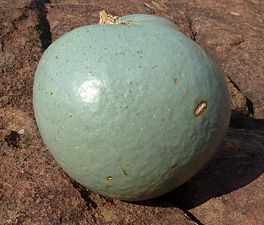en
names in breadcrumbs


This plant can adapt its habit from a shrub to a tree usually 5 metres tall, but can vary due to environmental needs from 1 to 15 metres; it occurs in southern Africa from tropical to subtropical dry climate. The large fruit (up to 12 cm) is edible but the seeds are usually spat out because are slightly poisonous.
Strychnos pungens (English: spine-leaved monkey-orange, Afrikaans: Stekelblaarklapper) is a tree which belongs to the Loganiaceae. Usually about 5m tall, occurring in mixed woodland or in rocky places. Branches are short and rigid. Leaves are smooth, stiff, opposite, elliptic and with a sharp, spine-like tip. Occurring in South Africa on the Witwatersrand, Magaliesberg and further north to northern Namibia, northern Botswana and Zimbabwe.
The fruit is large (120mm diameter), round and with a smooth hard shell, bluish-green in colour and turning yellow when ripe. The pulp of ripe fruit is rich in citric acid and is edible, but the seeds are mildly poisonous. The tree is a close relative of Strychnos nux-vomica, the source of strychnine.
Strychnos pungens (English: spine-leaved monkey-orange, Afrikaans: Stekelblaarklapper) is a tree which belongs to the Loganiaceae. Usually about 5m tall, occurring in mixed woodland or in rocky places. Branches are short and rigid. Leaves are smooth, stiff, opposite, elliptic and with a sharp, spine-like tip. Occurring in South Africa on the Witwatersrand, Magaliesberg and further north to northern Namibia, northern Botswana and Zimbabwe.
The fruit is large (120mm diameter), round and with a smooth hard shell, bluish-green in colour and turning yellow when ripe. The pulp of ripe fruit is rich in citric acid and is edible, but the seeds are mildly poisonous. The tree is a close relative of Strychnos nux-vomica, the source of strychnine.
 bark
bark  foliage
foliage  flowers
flowers  fruit
fruit